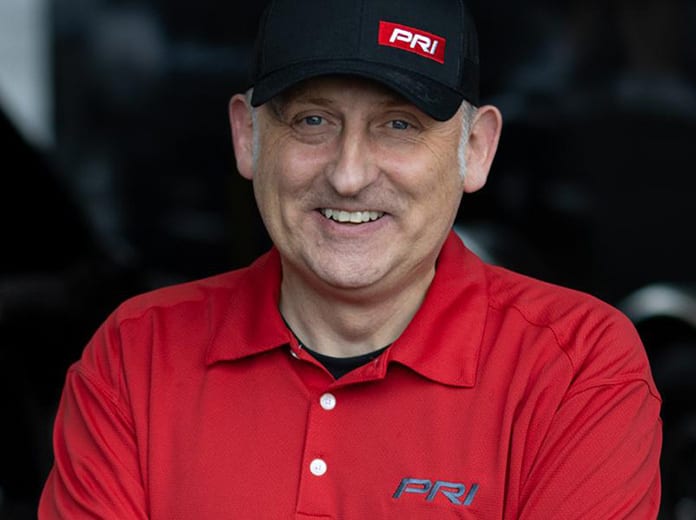The COVID-19 pandemic has changed all our lives in one way or another, but few have ridden the roller coaster that Dr. Jamie Meyer has been on since becoming the first president of Performance Racing Industry early this year.
In that position, Meyer is charged with staging the racing and high-performance industries’ biggest trade show, commonly called the PRI Show, which is under contract to be held at the Indianapolis Convention Center through 2025.
Meyer started his new position bursting with enthusiasm but was immediately confronted by the pandemic.
After months of trying to keep the PRI Show on schedule, meeting with all sorts of government and corporate entities, the show was canceled for the first time in its 34-year history in mid-September.
“Honestly, 2020 has been tough on everybody,” Meyer told SPEED SPORT. “We’ve all become crisis management specialists. It was a very tough decision to cancel the show, but we had a great team that worked together to explore every possibility. Bill Miller (senior vice president of operations for the Specialty Equipment Market Ass’n, which owns both the PRI Trade Show and Performance Racing Industry Magazine) and Chris Kersting (president and chief executive officer of SEMA) gave me a running head start when I took the position. We had great people in Indianapolis to work with, including the Visit Indy team (Indianapolis and the Indianapolis Convention Center’s sales and marketing arm) and Andy Mallon, executive director of the Indiana Convention Center and Lucas Oil Stadium.
“We worked with the Marion County Health Department,” Meyer continued. “It was a matter of the Marion County Health Department doing all the right things to keep the community safe. But eventually it was going to mean that there were restrictions on our capacity and the return on investment for our exhibitors and attendees just wasn’t going to be there.”
The cancellation of both the SEMA Show, which was supposed to be held Nov. 3-6 in Las Vegas but ended up being online only, and the PRI Show were big hits to SEMA and PRI’s bottom lines. Meyer didn’t disclose any figures, but he admitted, “without the SEMA Show and without the PRI Show, our main source of income has been lost for 2020.
“The qualifier is there are many businesses in the high-performance and racing industry that are going through the same thing,” he added. “We’re still positive about the American spirit and the racing spirit and how we’re going to come out of this positively.”

It certainly hasn’t been what Meyer envisioned for his first few months on the job.
“I’m in the Detroit area still; my wife and I are actively looking for a home in Indianapolis,” he said. “The whole world seems to have gone viral and I spend a great deal of my day on Skype, Google Meet, Zoom, Facetime and other similar platforms. I’ve traveled to Indy several times, though. I wanted to be there for the first NHRA race when they came back and I’ve been on several stops on the PRI Road Tour.
“I think for everyone who takes a leadership position in a company, there is going to be a period of adjustment until you get to know your people and your customers,” noted Meyer, who came to the PRI presidency after 15 years with General Motors.
“This culture is decidedly different than what I had at GM,” he continued. “SEMA is a much more nimble company and it can react fairly quickly to changing situations. There is a true commitment to serve the SEMA members and that has carried over to the PRI staff. They have a 100 percent commitment to serve the racing community through the PRI Show, the PRI magazine and through our growing social media channels.”
Everyone is waiting for a vaccine to fight COVID-19, preferably sooner rather than later. When life gets back to normal, Meyer has set some goals for PRI.
“I was hired to continue the effort of the SEMA board to promote the racing industry,” he said. “One of the biggest tasks is to increase memberships of both businesses and individuals. We have a great platform in PRI. It is a trusted brand and the staff and membership have done a great job to be a great value to the racing industry.
“But there are several factions within the world that are challenging to our industry,” he continued. “The threats to this lifestyle are real. They come from non-racers’ perceived ideas on racing’s impact on the environment, the perceived impact we have to street-legal emissions and the perception that racers are damaging the environment. There is a government affairs agency in Washington, D.C., that works for both PRI and SEMA, and we still have Tom Deery on staff as a consultant. PRI is working with several race tracks and with their state governments so they can remain open and viable. We have had coalitions in Illinois, New York and New Mexico, and we’ve had variable levels of success with each effort.”
The PRI Show’s main thrust has always been to provide an opportunity for racing companies to showcase their products and for networking.
“It’s the coming together of like-minded individuals,” Meyer said. “Our slogan has always been ‘Where the business of racing is done.’ If you’re serious about a career in racing, you have to be involved in PRI.”
The racing industry is foregoing its annual pilgrimage to Indianapolis this month and taking part in things such as the PRI Road Show instead.
“I encourage all racers to stay connected to PRI,” Meyer concluded. “Get the free magazine, watch the website and sign up for the e-newsletter. Follow us on social media, where we have a renewed commitment to provide great content for them. And maybe I’ll see them on the PRI Road Tour.”
